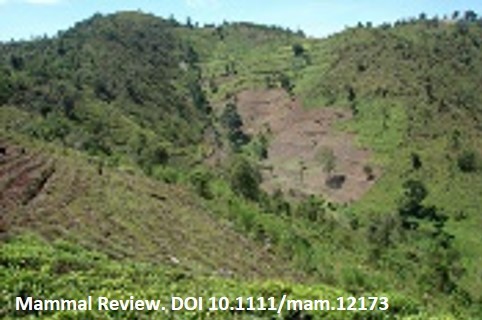A significant link between forest loss and fragmentation and outbreaks of Ebola virus disease (EVD) in humans has been documented. Deforestation may alter the natural circulation of viruses and change the composition, abundance, behaviour and possibly viral exposure of reservoir species. This in turn might increase contact between infected animals and humans. Fruit bats of the family Pteropodidae have been suspected as reservoirs of the Ebola virus. At present, the only evidence associating fruit bats with EVD is the presence of seropositive individuals in eight species and polymerase chain reaction-positive individuals in three of these. This study investigates whether human activities can increase African fruit bat geographical ranges and whether this influence overlaps geographically with EVD outbreaks that, in turn, are favoured by deforestation. Species observation records were used for the 20 fruit bat species found in favourable areas for the Ebola virus to determine factors affecting the bats' range inside the predicted Ebola virus area. The range of some fruit bat species appeared to be linked to human activities within the favourable areas for the Ebola virus. More specifically, the areas where human activities favour the presence of five fruit bat species overlap with the areas where EVD outbreaks in humans were themselves favoured by deforestation. These five species are as follows: Eidolon helvum, Epomops franqueti, Megaloglossus woermanni, Micropteropus pusillus and Rousettus aegyptiacus. Of these five, all but Megaloglossus woermanni have recorded seropositive individuals. For the remaining 15 bat species, no biogeographical support was found for the hypothesis that positive human influence on fruit bats could be associated with EVD outbreaks in deforested areas within the tropical forest biome in West and Central Africa. This work is a useful first step allowing further investigation of the networks and pathways that may lead to an EVD outbreak. The modelling framework employed in this study can be used for other emerging infectious diseases. informacion[at]ebd.csic.es: Olivero et al (2019) Human activities link fruit bat presence to Ebola virus disease outbreaks. Mammal Review. DOI 10.1111/mam.12173
https://onlinelibrary.wiley.com/doi/full/10.1111/mam.12173








 Las altas temperaturas están provocando que las lagunas y las marismas de Doñana pierdan agua rápidamente
Las altas temperaturas están provocando que las lagunas y las marismas de Doñana pierdan agua rápidamente



